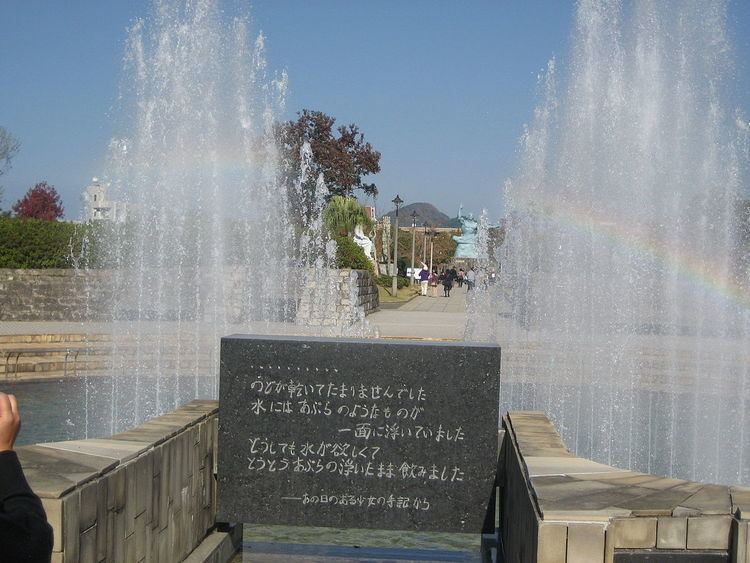Type Park with statues Opening date April 1, 1955 Phone +81 95-829-1171 | Designer Seibou Kitamura Height 10 metres (33 ft) Opened 1 April 1955 | |
 | ||
Dedicated to Victims of the atomic bomb explosion on August 9, 1945 Hours Open today · Open 24 hoursVernal Equinox Day might affect these hoursMonday(Vernal Equinox Day)Open 24 hoursHours might differTuesdayOpen 24 hoursWednesdayOpen 24 hoursThursdayOpen 24 hoursFridayOpen 24 hoursSaturdayOpen 24 hoursSundayOpen 24 hours Similar Nagasaki Atomic Bomb Mu, Immaculate Conception Cathedral, Glover Garden, Ōura Church, Mount Inasa | ||
Nagasaki peace park and a bomb hypocenter
Nagasaki Peace Park is a park located in Nagasaki, Japan, commemorating the atomic bombing of the city on August 9, 1945 during World War II. It is next to the Atomic Bomb Museum and near the Peace Memorial Hall.
Contents
- Nagasaki peace park and a bomb hypocenter
- Japan nagasaki peace park
- History
- Plaque
- Peace Memorial Ceremony
- Peace Symbols Zone
- References
Japan nagasaki peace park
History
Established in 1955, and near to the hypocenter of the explosion, remnants of a concrete wall of Urakami Cathedral can still be seen. Urakami Cathedral was the grandest church in east Asia at the time. At the park's north end is the 10-meter-tall Peace Statue created by sculptor Seibo Kitamura of Nagasaki Prefecture. The statue's right hand points to the threat of nuclear weapons while the extended left hand symbolizes eternal peace. The mild face symbolizes divine grace and the gently closed eyes offer a prayer for the repose of the bomb victims' souls. The folded right leg and extended left leg signify both meditation and the initiative to stand up and rescue the people of the world. The statue represents a mixture of western and eastern art, religion, and ideology. Installed in front of the statue is a black marble vault containing the names of the atomic bomb victims and survivors who died in subsequent years. A plaque by the Peace Statue is titled Words from the Sculptor and reads:
Plaque
A plaque at the nearby hypocenter gives the following account and statistics of the damage caused that day.
At 11:02 A.M., August 9, 1945 an atomic bomb exploded 500 meters above this spot. The black stone monolith marks the hypocenter.
The fierce blast wind, heat rays reaching several thousand degrees and deadly radiation generated by the explosion crushed, burned, and killed everything in sight and reduced this entire area to a barren field of rubble.
About one-third of Nagasaki City was destroyed and 150,000 people killed or injured and it was said at the time that this area would be devoid of vegetation for 75 years. Now, the hypocenter remains as an international peace park and a symbol of the aspiration for world harmony.
(Large numbers of people have died in the following years from the effects of radioactive poisoning.)
Peace Memorial Ceremony
Every year, on 9 August, the anniversary of the atomic bombing, a Peace Memorial Ceremony is held in front of the statue and the Mayor of Nagasaki delivers a Peace Declaration to the World.
At the south end of the park is a "Fountain of Peace". This was constructed in August, 1969, as a prayer for the repose of the souls of the many atomic bomb victims who died searching for water, and as a dedication to world peace. Lines from a poem by a girl named Sachiko Yamaguchi, who was nine at the time of the bombing, are carved on a black stone plaque in front of the fountain. It reads: "I was thirsty beyond endurance. There was something oily on the surface of the water, but I wanted water so badly that I drank it just as it was."
Peace Symbols Zone
In 1978 the city of Nagasaki established a "Peace Symbols Zone" on both sides of the park and invited donations of monuments from countries round the world. The following monuments can be seen in the park:
The Monument for Korean Atomic Victims is located in Nagasaki Peace Park in Nagasaki, Japan. At the time of the atomic bombing in Nagasaki, there were many people of nationalities other than Japanese that were living in the area. There were an estimated 12,000 to 14,000 Koreans living in Nagasaki during the bombing. It is believed that up to 2,000 of them died because of the atomic bomb. At the time, those Koreans were being used as forced labor as a part of the Japanese war effort. This monument commemorates the Korean victims and serves as a message asking for peace in the world, an abolition of nuclear weapons, and a peaceful reunification of the Korean nation. The Monument for Korean Atomic Victims was unveiled on August 9, 1979.
